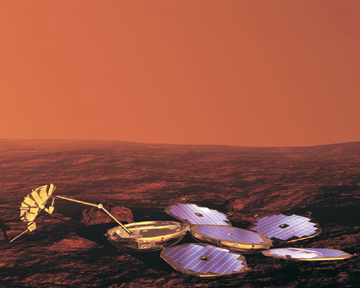
Geotimes Home | AGI Home | Information Services | Geoscience Education | Public Policy | Programs | Publications | Careers

 It’s summer
2003 — the summer of Mars. Two space agencies have monumental missions in
the works. From Cape Canaveral, two Mars Exploration Rovers (MER) — touted
as the most sophisticated robot geologists NASA’s $800 million could buy
— are on their way, set to arrive on the Red Planet in January (see Geotimes,
May 2003). Meanwhile, from Baikonur in Kazakhstan, the European Space Agency’s
(ESA) Mars Express orbiter, transporting the British-designed and possibly life-detecting
Beagle II lander, blasted off aboard a Soyuz-Fregat launcher on June 2. The Mars
Express mission, though geared toward biology, has the potential to answer a few
geological questions.
It’s summer
2003 — the summer of Mars. Two space agencies have monumental missions in
the works. From Cape Canaveral, two Mars Exploration Rovers (MER) — touted
as the most sophisticated robot geologists NASA’s $800 million could buy
— are on their way, set to arrive on the Red Planet in January (see Geotimes,
May 2003). Meanwhile, from Baikonur in Kazakhstan, the European Space Agency’s
(ESA) Mars Express orbiter, transporting the British-designed and possibly life-detecting
Beagle II lander, blasted off aboard a Soyuz-Fregat launcher on June 2. The Mars
Express mission, though geared toward biology, has the potential to answer a few
geological questions.  |
Geotimes Home | AGI Home | Information Services | Geoscience Education | Public Policy | Programs | Publications | Careers |